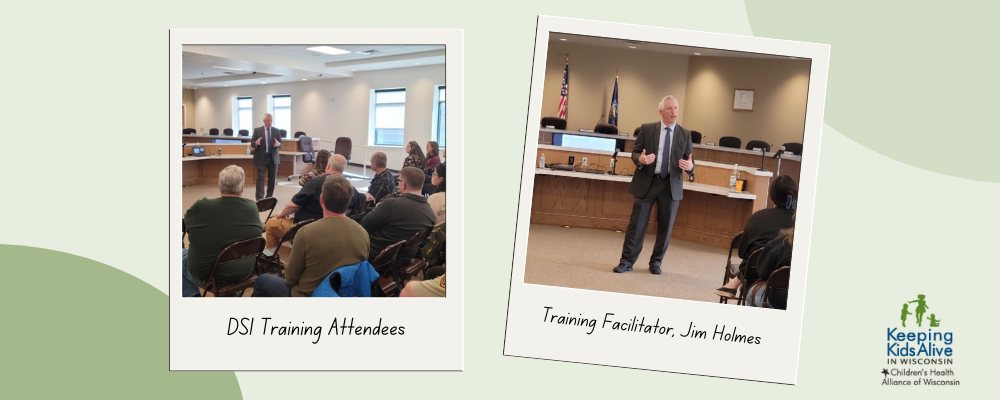The death of a child is a tragedy that should invoke a community response. Each year, more than 350 children, ages 0 to 17, die in Wisconsin for various reasons. Understanding the risk factors and circumstances that contributed, can help communities identify strategies that can prevent other child deaths. Conducting a comprehensive death scene investigation (DSI) is a strategy used to obtain an accurate account of what happened in each situation.
Quality DSIs are critical to obtain a clear picture of the incident and should consist of collaborative efforts from multidisciplinary agencies, such as law enforcement, coroners, medical examiners (MEs) and child abuse professionals. The investigation should also include a doll reenactment, which should be performed by a trained member of the investigative team to appropriately determine the cause and manner of death. However, data in Wisconsin’s Child Death Review (CDR) Case Reporting System (CRS) indicate that 20% of deaths reviewed in 2020-2022 did not include a comprehensive scene investigation. Additional data revealed that staff turnover, organizational capacity and skill level vary greatly between jurisdictions across Wisconsin, causing a lack of uniformity in scene investigations statewide.
For nearly 20 years, Children’s Health Alliance of Wisconsin (the Alliance) has collaborated with statewide partners to reduce the number of infants and children who suffer unexpected injuries that result in death. The Alliance oversees the Keeping Kids Alive (KKA) program, which maintains a comprehensive fatality review system that includes CDR, fetal infant mortality review (FIMR) and other special surveillance projects. CDR is a process used by local multidisciplinary teams to share and discuss infant and child deaths to understand how and why children die. Teams then use the findings to inform actionable prevention.
Death scene investigation and doll reenactment training
The Alliance recently collaborated with the Department of Justice (DOJ) and the Milwaukee County Medical Examiner’s Office (MCMEO) to address the variance in comprehensive DSIs by conducting five trainings throughout the state. These trainings were held in rural areas where there are typically fewer resources available to conduct complete scene investigations and fewer options for staff to receive trainings. Participating agencies received a kit containing an investigation doll, a photography card to help determine how a child was placed and found at the scene and resources such as the Centers for Disease Control and Prevention’s (CDC) Sudden Unexpected Infant Death Investigation (SUIDI) reporting form.
The trainings were facilitated by James Holmes, special agent in the Division of Criminal Investigation at DOJ, and Hillary Donald, forensic investigator at the MCMEO.
“Most of Wisconsin is comprised of rural communities, so it made sense to hold the trainings in these areas,” Holmes explains. “We wanted attendees to easily access the trainings without being restricted by travel. All five sessions were at maximum capacity with long wait lists and there was a lot of participation, which illustrates the level of interest rural agencies have in receiving the training.”
“Milwaukee County has a high volume of child death scene investigations. I have likely had more cases in the last year than entire counties or areas of the state,” notes Donald. “I utilize my skills frequently, but because rural areas have fewer cases, more resources are required to make sure everyone is prepared when a death scene investigation is necessary.”
More than 365 attendees representing 176 agencies learned the skills and tools necessary to conduct thorough DSIs, such as directing caregiver interviews, completing scene investigations, performing doll reenactments and working with coroners and MEs to ensure a thorough forensic examination is completed.
“There are a lot of details encompassed within the training,” says Holmes. “By distilling everything down into four steps, it simplifies things for death scene investigators and helps them easily remember what to do when they are examining a case and things are stressful.”
Attendees spanned a range of disciplines, including coroners, medical examiners, law enforcement personnel, emergency medical service (EMS) agencies, emergency department providers, child abuse clinicians and child protective services (CPS). The sessions were well-received by attendees; based on the post-survey, 99% of attendees would recommend this training to a colleague, and attendees were grateful to receive a DSI kit that included helpful resources for their continued education.
“The trainings brought together experts across counties and jurisdictions who may not normally communicate,” says Donald. “These sessions provided an opportunity for them to learn from each other and make lasting connections, and will ultimately result in opportunities to improve practices that lead to child death prevention.”
“Attendees have an increased understanding of why it is important to thoroughly investigate scenes that resulted in childhood injuries and fatalities,” says Holmes. “Complete scene investigations allow communities to determine where systemic gaps exist and identify collaborative ways to address them in an effort to reduce unexpected infant and child fatalities.”
Improving death scene investigation infrastructure and future efforts
Donald and Holmes both emphasize that attending the trainings is not the only strategy attendees should use to conduct thorough DSIs in their jurisdictions. “It’s important to constantly read new evidence-based guidelines and update skills based on current trends,” maintains Holmes. Donald says, “The trainings encouraged people to take a multidisciplinary approach to investigate cases and work across agencies, including law enforcement, medical examiners and CPS.”
Holmes and Donald are confident that these trainings will increase the quality of DSIs and will include the four components of a comprehensive investigation, including a doll reenactment, throughout Wisconsin. “The trainings ensure that when an agency responds to a future child fatality, they will be equipped to do a complete investigation,” stresses Holmes. “We raise awareness so that communities who do not currently have child death review teams will form them and begin examining cases to improve injury and death prevention. Further, communities who have existing child death review teams can now consistently perform thorough investigations thanks to this education.”
The Alliance will continue to offer DSI trainings across Wisconsin as additional funding is secured.
“There’s always a need for continuing training due to maintaining competency and working around staff turnover,” says Holmes. “People who conduct child death scene investigations should train frequently enough that competency around these cases becomes part of their normal course of business. During the week of sessions, there were numerous attendees who I have trained before; it was great to see them return for a refresher course so their skills and knowledge stay current.”
The Alliance thanks the Wisconsin Department of Health Services and the National Center for Fatality Review and Prevention (NCFRP) for their sponsorship and support in making these trainings possible.


